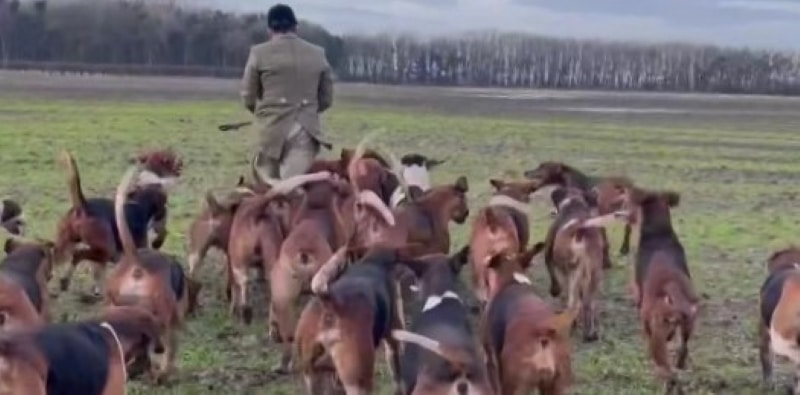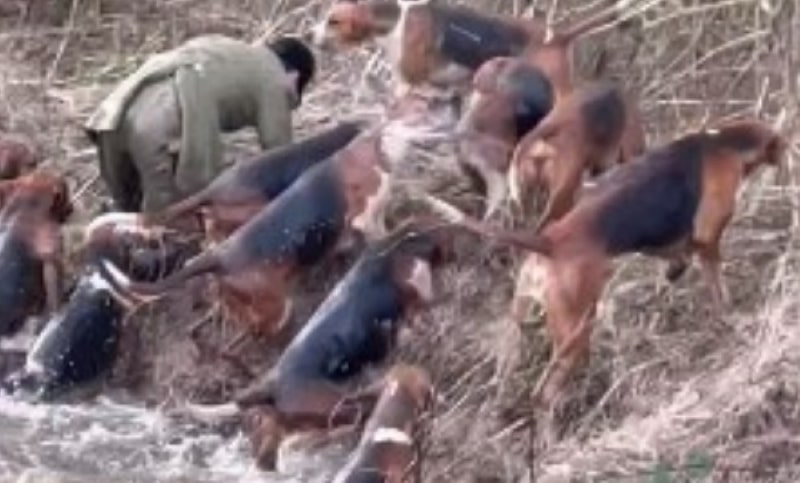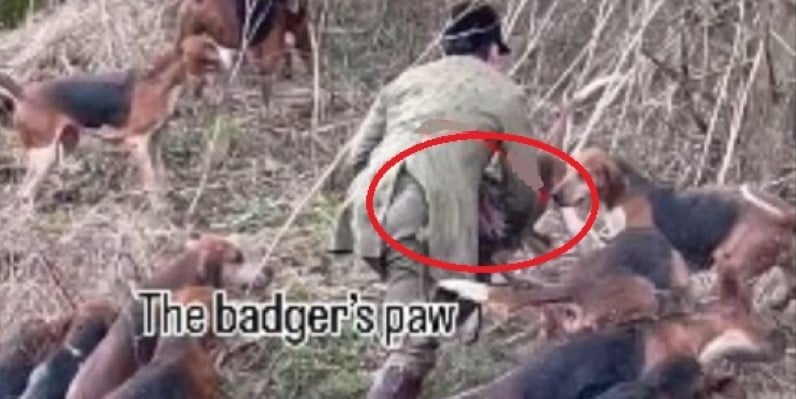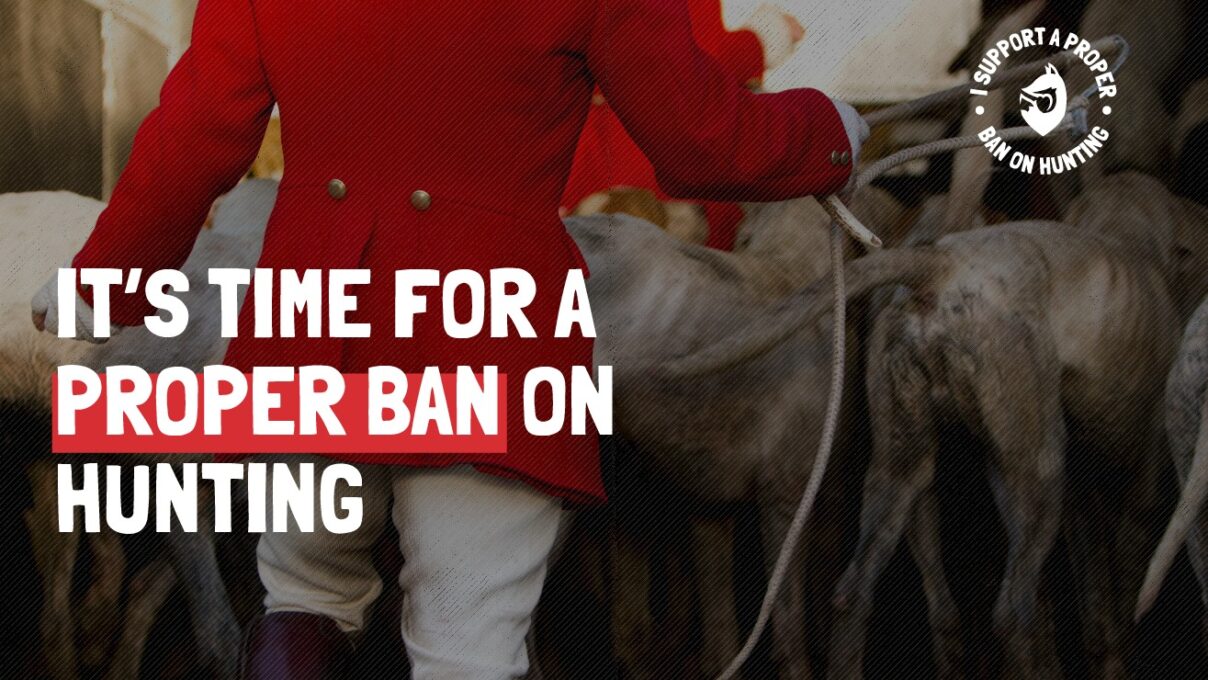On 27 January this year, Hull Wildlife Protectors (HWP) were monitoring the Holderness Hunt (who are based at Etton, near Beverly) when they witnessed a fox fleeing across one of the region’s wide flat fields. Huntsman Tom Wright (formerly with the notorious Cheshire Forest Hunt) was seen to deliberately lead the hunt’s hounds along the line of the running fox, which evidently ran into and through a small copse.
Soon afterwards the hounds were heard making a kill. As the monitors reached the hounds they realised that it wasn’t a fox that had been savaged, but a badger. As HWP say on their Facebook page:
“This incident underscores that foxes aren’t the sole victims of “trail hunts”. The foxhounds, trained on live prey, exhibit heightened aggression in their presence, endangering various wildlife species.”
The monitors continued to film as they run after Wright to try to retrieve the badger’s body, and that ‘chase’ makes up the bulk of the footage HWP has shared with us.
* Just to be clear the following footage is not graphic – the badger kill is not recorded – but it may be upsetting for some viewers.
Has a crime been committed?
Under the Hunting Act 2004, it is an offence to hunt wild mammals with dogs. The Act says that “if a person has with him or her a dog and is hunting a wild mammal” he or she is guilty of an offence. There are exemptions including so-called ‘trail hunting’. Another exemption alludes to “Stalking and flushing out a wild mammal for certain purposes, with a view to its being shot forthwith” but that must not be done using more than two dogs and the flushed animal must be shot almost immediately.
.
- Foxes don’t have much protection in law, but there is little doubt that a hunt has taken place. Wright sent a pack of hounds after the fox. There was no scent trail laid in advance across the field for the hounds to follow (there rarely – if ever – is a trail, of course) and even if one had been laid it wouldn’t have lasted for long in the wet and cold conditions. The fox was not being flushed to a gun: the fox was being hunted.
Unlike foxes (and despite what the National Farmers Union and cull operators might believe) badgers are protected. Under the Protection of Badgers Act 1992, it is an offence in England and Wales (the law is basically the same in Scotland and Northern Ireland) for an individual to:
- Wilfully kill, injure or take a badger (or attempt to do so).
- Have in their possession or under their control any dead badger or any part of, or anything derived from, a dead badger.
Perhaps just as relevantly (though whether the Hunt would know this unless they routinely kill badgers?) Section 13 of the Act also says:
- Where a dog has been used in or was present at the commission of an offence …the court, on convicting the offender, may, in addition to or in substitution for any other punishment, make either or both of the following orders—
- (a) an order for the destruction or other disposal of the dog;
- (b) an order disqualifying the offender, for such period as it thinks fit, for having custody of a dog.

Hull Wildlife Protectors witnessed the hunt. A badger was killed. A pack of dogs under the control of the hunt was present. The Huntsman coordinated and conspired with other members of the hunt to remove and dispose of the body.
All of that should surely at least be enough for a case to be tried?
No, unfortunately not. As is so often the case with hunting and wildlife crime, Humberside Police have decided not to proceed against the Holderness Hunt citing a lack of ‘sufficient evidence’.
This is exactly what the same force said when HWP recorded a fox being killed by the Holderness Hunt in the autumn last year (see “Holderness Hunt kills fox in front of monitors, police take ‘no further action‘”). HWP are understandably frustrated and disappointed, but they stress that they have a good working relationship with the force’s Rural Crime Team and that their issue is with the Hunting Act legislation and the ‘burden of proof’ evidentiary bar – not with the police.
So what’s going on here?
As always, we should make clear at this point that Protect the Wild are not lawyers. Like everyone else we struggle to make sense of the law sometimes, and if a qualified individual is interested in conforming or correcting our interpretation of events we would be grateful.
We have to agree with Humberside Police. There is not ‘sufficient evidence’. The ‘evidence’ bar for a prosecution under the Hunting Act is set very high (which indeed should be the case with all crimes of course – none of us would want to be convicted on anything other than incontrovertible evidence), and includes two important elements: an individual must be charged with a crime (at the moment as far as we can tell a ‘hunt’ is not liable under the terms of the Hunting Act); and there must be intention.
It’s not – unfortunately – enough to say that ‘an animal was killed by a hunt’ so go ahead and charge them. The prosecution must be able to prove without reasonable doubt precisely who did the killing or who precisely was in charge when the kill occurred (the dogs can’t be charged as animals aren’t considered to have ‘moral agency’ and not capable of knowingly committing a crime). They also need to prove that the kill was intentional and not an accident.
There are roles within the hunt of course, and Wright as Huntsman is responsible for directing the hounds. But in every criminal case the prosecution must prove the identity of the ‘person who perpetrated or participated in the commission of an offence‘. Defendants in hunting cases will often claim that the evidence being presented doesn’t specifically identify them as the individual allegedly hunting illegally. Intent – ‘the decision to bring about a prohibited consequence’ – is also critical, and has been leapt on by hunts (and their defence attorneys) because successful Hunting Act prosecutions must prove that hunts meant or intended to kill.
Could the police say with any certainty that Wright himself intentionally directed the hounds to kill a protected mammal – in other words, to kill the badger?
There is no video evidence to suggest that, and there is no video evidence to suggest that the Holderness Hunt intentionally killed the badger at all. In fact, while hunts routinely block badger setts to stop foxes bolting underground, as far as we know actually killing a badger in this way is very rare (monitors or sabs who know differently please let us know).
What we can see in the video – which we’re told is pretty much what Humberside Police would also have seen – is the aftermath of a kill, and a disgraceful (but successful) attempt to hide and remove the body of a dead badger. It would be almost amusing (Wright struggling out of a dyke filled with cold water will undoubtedly be making the rounds of ‘classic fails’ for many years) were it not for the fact that these men have killed a protected species and deliberately conspired to remove the evidence of a potential wildlife crime.
None of this is to denigrate the heroic efforts of the HWP volunteer who took off after Wright in any way at all, incidentally. Hunt support impeded them, the ground made for very heavy going, and they also had to navigate around a pack of highly excited dogs – and the same dyke Wright ended up floundering out of.

What does running away prove?
One of the most puzzling things about all of this is why Wright took off like he did.
If he’d stopped and thought (which perhaps is a bit of a stretch for a Huntsman), he might have realised that there was no proof that he intentionally (or wilfully, in the words of the Badger Act) killed the badger. He could have said that the badger was already dead – and if there was blood present that the dogs attacked the corpse. He could have even held his hands up and admitted the ‘mistake’.
Hunts of course don’t admit ‘mistakes’. They don’t take responsibility. They don’t have the integrity or the moral compass that the rest of us possess. They’re not adults in the sense of being mature enough to behave like respectable citizens and own up when they fail. Their traditions are anachronistic, anathema to most of society. They lie, prevaricate, and twist the truth, relying on hiding behind excuses and loopholes and vague definitions. They lack honour.
In Wright’s specific case we can only assume he is not very good at his job, that he panicked when he saw the dead badger, that he doesn’t know the law (or has been in front of the law too often for his own liking and didn’t want to repeat the experience), that he thought he might be responsible for the Hunt having their hounds taken away, and – like a lot of petty criminals – he figured the best bet was to hide the evidence as quickly as possible.
So he ran away. Guilty as hell and frightened of being splashed across the internet with blood-stained hands and a lifeless protected mammal in his arms.

Again, we’re making assumptions, but he probably thought he was helping the Hunt as he waddled across the mud, running in that weird way we all do when we’re carrying something heavy and can’t use our arms. But he hasn’t – he’s made them look like lawbreakers.
He probably figured he was athletic enough to hurdle a dyke – until he discovered gravity and carrying a badger corpse would make it hard for even an Olympic long jumper to clear a slippery ditch.
He probably thought he was being a really good little boy when he handed over the corpse and leant back against a tree, sodden, panting, and smirking. That the Hunt would cheer him in the pub for ‘saving the day’ instead of realising how stupid a mistake they had just made.
He may have even figured that once the body was taken away no one would ever know anyway, so no harm done. But he couldn’t be more wrong. 40k+ people will now see him and – even without a conviction – they will KNOW what happened and what he has done.
-
The Holderness Hunt – ‘a struggling hunt propped up by inherited wealth and a rag-tag bunch of supporters’ – has previously featured in a post by the Secret Monitor.
- Many thanks to Hull Wildlife Protectors for sharing their footage with us and for commenting on a draft of this post. Hull Wildlife Protectors are on Facebook at /HullWildlifeProtectors/ and can be contacted at Hullwildlifeprotectors@gmail.com

Illegal hunting must end. Protect the Wild is proposing a new Bill that if it becomes law would be called the Hunting of Mammals Act. Amongst the many improvements it would make to existing legislation would be to remove those exemptions and loopholes (so no ‘trail laying’ excuse) and, crucially, make it clear that hunts would be criminally liable if they are ‘reckless’.
In law, ‘recklessness’ means unjustified risk-taking and a person acts recklessly with respect to:
- a circumstance when they are aware of a risk that it exists or will exist;
- a result when they are aware of a risk that it will occur;
- it is in the circumstances known to them to be unreasonable to take the risk
In other words, had the Hunting of Mammals Act been in place the Holderness Hunt could have been charged with illegal hunting because they would have been reckless in taking hounds trained to kill foxes into the countryside and then knowing that the hounds were ‘in cry’ took an unjustifiable risk that a mammal would be killed by not calling them to heel.
Full details of our Bill (which was written with the highly-regarded legal firm Advocates for Animals) are posted on our website.
With our Bill, hunting would finally end for good.

